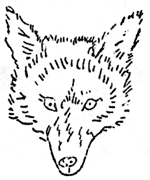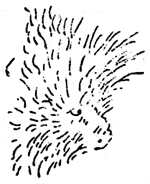More About Bugs
By Earl U. Homuth
In previous issues of Nature Notes appeared a series of articles dealing with the efforts toward control and eradication of the Mountain Pine Beetle (Dendroctonus monticolae,Hopk.) which had attacked and threatened to destroy the pine forests of Crater Lake National Park and the surrounding areas.
As mentioned in those articles, the beetle is destructive, due to the fact that the larvae feed upon the cambium or living layer of the tree, horizontally from chambers in which the eggs are laid by the adult.
The solar method of control consists of felling the infested trees, exposing them to the sun. A sun temperature of 85 degrees for a period of one hour serves to destroy the eggs, larvae, pupae and immature beetles in the tree. The trees are subsequently rolled half over, thus exposing all surfaces.
Control work for a season must be completed or terminated by July 1 since by that time adult beetles emerge from the trees and subsequent work would be useless. The work for this season covered the period from April 30 to June 30. Due to a mild winter and early spring, and with experience gained in previous years the work was more rapidly advanced.
The number of trees treated this year totaled 14,747 over an area of 16,500 acres. This gives an average of .893 trees per acre. In 1930 the average was 2.2 and in 1929 it was 4.4 trees per acre.
When figures, covering the work of the past three seasons, are studied, they prove enlightening.
In areas completely treated in 1929, the average decrease of infestation in 1930 was 74 percent. The average decrease in 1931, over 86.1 percent.
In units incompletely treated the infestation showed an increase, in one instance, of 59.5 percent in one year and in another instance 82.8 percent in one year.
Observations in areas not treated indicate that the increase may run from 50 to 200 percent.
It may be concluded from the complete figures on file that partial or incomplete treatment is useless and that treating in areas subject to reinfestation is also unsatisfactory. Only complete treatment of all affected areas in one season will produce the desired results.
It may also be concluded that although the work has not been a complete success, yet, had nothing been done, the pine forests of the southern part of the park would present the same appearance of a “ghost forest” as is found upon 33,000 acres in the northern portion.
It is also obvious that the present incomplete treating will eventually eliminate all pine stands by cutting.
In conclusion it may be mentioned that the solar method of control was developed in Crater Lake National Park and that progress and results indicate that the method is successful, provided the treatment of all infested areas is thorough and complete.
Protection for the Coyotes
By Frank Solinsky
Many campers, while gathered around their evening fires, have been thrilled and held spellbound by an eerie call. The uninitiated conjures images of an attack by ferocious beasts but to the woodsman it is the wild and beautiful bark of a coyote.
Recently five coyote pups were found in the woods about two miles below Government Camp, by two of the Beetle Control men. The men played with the pups, which were about a month old, for half an hour and then left them unharmed. The den was under a large log and in front of the den was a dead porcupine. The coyote has the enviable ability of being able to kill a porcupine without injury to himself.
Possibly it will be remarked that since the coyote is a pest, the pups should have been destroyed. Although such is the practice in some of the parks, the authorities here at Crater Lake feel that the coyote is an integral part of the woods and should be protected. In fact, the coyote almost balances his good with his bad, for although he kills grouse and other birds and small animals, he also preys on the destructive porcupines, gophers and rabbits.
Pacific Belt of Volcanic Activity
By W. Layton Stanton, Jr., Ranger Naturalist
How many of us realize that Crater Lake lies in a belt of volcanic activity which entirely circles the Pacific Ocean? In the far north there are many evidences of volcanic eruption along the Aleutian peninsular of Alaska. This zone curves southward and extends along the western border of North America, South America and then westward across the southern Pacific Ocean. Many of the south sea islands, all of which owe their origin to volcanic eruptions, lie in this belt. The same conditions exist in the East Indies and along the eastern margin of Asia, thus completing the circle. Although the remnant of ancient Mount Mazama is but one of many thousands of volcanic peaks occurring in this zone, it is unique in that nowhere else is there found a lake, nestled in a crater or caldera, which can compare with our own Crater Lake.
Just what causes this great volcanic belt, science does not know. It must represent a zone of weakness in the crust of the earth through which molten rock and gases are able to reach the surface. But how may we explain the location of this relatively weak zone? That is another answered question. Some authorities believe that the weight of the ocean water pressing down on the ocean bottom forces subsurface material to either side, much as a block of wood might do if pressed down into a mass of heavy mud. This action might be expected to push up mountains along the continental margins and force molten rock and gas through the crust of the earth.
We should remember that Crater Lake and Mount Mazama, although magnificent and awesome in themselves, are expressions of some great system of forces which are continually at work in shaping our earth.
***previous*** — ***next***



